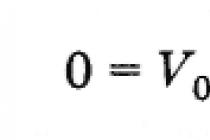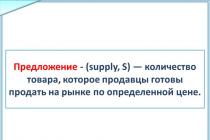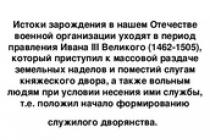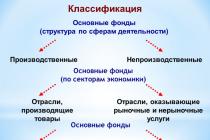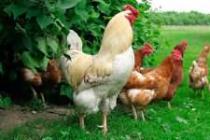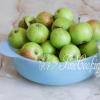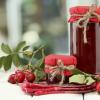I found out that invert syrup can be prepared at home just yesterday. My son came to visit, and even though he is already an adult, he really loves sweets: not ordinary candies, but various foreign novelties. I asked him to make marshmallows. I remembered that I saw the recipe for making them on the “Very Tasty” website. But it turned out that I didn’t have the most important ingredient - invert syrup. I couldn’t find it in our stores either. Thanks to the video of the YouTube channel - such a recipe was found, and it turned out that even a child can prepare invert syrup at home. At the same time, it is very useful: it replaces molasses, glucose, corn syrup, and artificial honey.
Ingredients:
- 350 grams of sugar;
- 155 milliliters of water;
- 2 grams (0.5 teaspoon) citric acid;
- 1.5 grams of soda (a little less than half a teaspoon).
Homemade invert syrup. Step by step recipe
- Pour water into a saucepan (saucepan) with a thick bottom, add sugar, place over medium heat and stir until the sugar is completely dissolved.
- Bring to a boil, add citric acid (everything will foam a little), reduce heat to low, cover with a lid and leave the syrup to simmer.
- Cooking time depends on the strength of the fire, it varies for each person. Therefore, to avoid overcooking the syrup, it is better to use a thermometer. When the temperature of the syrup reaches 109-110 degrees, it is ready.
- There is another way to check the readiness of the syrup: approximately 20-30 minutes after boiling, when the syrup has already acquired a golden color, pour a tablespoon onto a plate and cool quickly (blow on it), then place it between two fingers, squeeze, and then spread your fingers - the syrup should stretch in the form of a thick thread.
- Let the syrup cool slightly (to 105-107 degrees) and add soda diluted with a small amount of warm water. The syrup should foam actively. Mix well and wait for the neutralization process to complete: the foam should completely settle (in about 10-15 minutes).
- If the foam does not settle and the syrup has acquired a cloudy color, add 1 tablespoon of water to it and put it on the fire again. Until it becomes transparent.
- The finished syrup, properly prepared, should be similar to fresh liquid honey - both in consistency and color (yellow-golden). If you overcook it a little and it turns caramel color, it’s okay, all the properties are preserved.
- Cool and pour into a jar, put in the refrigerator, where it can be stored for 2-3 months.
Invert syrup can be prepared very quickly at home and does not require the purchase of any special products - any housewife has everything she needs. But it is indispensable in the kitchen: it is one of the ingredients for many dishes. It is part of
Close Printing ingredients
In sweet recipes you can often find such a “beast” as glucose syrup (glucose). Few non-professionals know what it is and where to buy it. It is not sold in regular grocery stores! That's right. You can find glucose syrup in specialized confectionery stores or order it online. It can be replaced with molasses (although it is also not so easy to buy) or liquid honey, but then the finished product will have a honey taste and smell. Or you can do it differently - cook invert syrup! It is not difficult! Here's a step-by-step recipe with photos.
Take 300 g of sugar.

Place it in a small saucepan with a thick bottom.

Pour 130 g of hot water into it.

Place on low heat and cook, stirring, until the sugar dissolves.

Bring to a boil, add citric acid (1/3 tsp) and stir.

Reduce the heat to low, cover with a lid and wait)

Once the syrup reaches a temperature of 107-108 degrees, it is ready! We can check this using a cooking thermometer...

...or testing on a thick thread. Scoop up some syrup with a spoon and cool quickly by dripping onto ice or ice water. Grab a drop of syrup and quickly clench and unclench your fingers. If a thick thread stretches, then the syrup is ready!

The correct invert syrup, after cooling, is similar in color and consistency to light liquid honey.



We pour it into a jar with a lid and safely store it in the refrigerator for several months, from time to time using it to our confectionery interests :)

Now about the nuances. It is extremely important to cook in a thick-walled pan and on the lowest, pardon the oxymoron, heat! I heard that some housewives even periodically remove the pan from the stove for a couple of minutes during cooking so that the syrup does not heat up too quickly.
It is also very important not to overcook the syrup so that it does not darken, because then the icing based on it, for example, will be difficult to paint in bright colors. If you overcook it completely, it will become too thick and taste like burnt sugar. To be honest, despite all the tricks, my syrup always reaches the desired temperature, color and consistency earlier than they usually write in recipes: not in half an hour, and especially not in 45 minutes, but already in 20 minutes (usually even less). And it works! You don’t need to focus on the consistency of the hot syrup; it will seem liquid to you, but after cooling it will thicken. However, this is clearly demonstrated by a test on a thick thread, for which a drop of syrup is cooled.
I would like to note that, at the request of TV viewers, I recently weighed the finished syrup. From this amount of products I got 325 g. It would have come out more if I had poured the syrup into the jar while it was still warm. And I left it overnight in the cauldron in which I cooked it; it cooled down and thickened considerably, and some of the syrup remained on the walls when transferring.
And further. In the vast majority of recipes, it is customary to add soda at the end. It acts as a neutralizer, suppressing acid. But I never do this, and my syrup does its job perfectly, and the taste of lemon is not noticeable in it at all. So maybe I'm brewing invert syrup and not academically, but the most important thing is that I can do it! Which means you can do it too.
When you see words like glucose syrup, molasses, or corn syrup in a recipe, do you immediately close the recipe? But you can prepare invert syrup at home from simple and affordable products and replace any of these rare ingredients!
What is invert syrup used for? It will be useful for making marshmallows, marshmallows, it can be used in bread recipes and even replace glucose syrup in a mirror glaze recipe. I will not describe the chemical reactions that occur during the cooking of syrup, I will only tell you what the main difference between invert syrup and regular sugar is. Invert syrup has anti-crystallization properties; in other words, baked goods, marshmallows, cream or ganache prepared with this syrup will not become sugary during storage and will remain in their original form longer.
I will give three options for preparing invert syrup, the ingredients are the same, there are slight differences in the preparation technology.
The simplest invert syrup recipe
- Granulated sugar - 300 g
- Hot water - 130 ml
- Citric acid - 1 g (about 1/3 level teaspoon)
Place sugar in a saucepan, pour in hot water, cook, stirring, over medium heat. Bring to a boil, add citric acid, stir and reduce heat to low. Close the lid and cook for 25-35 minutes.
After about 25 minutes, check the readiness of the syrup; this can be done using a thermometer (the temperature should be 108 degrees) or test on a thick thread. Place a little syrup on a saucer of ice water, grab the drop between your thumb and forefinger and squeeze and unclench it several times. If you see a thread of syrup 4-5 mm thick, the syrup is ready; if the thread is thin, cook the syrup for another 10-15 minutes.
Cool the finished syrup and pour into a glass jar. Store at room temperature for up to a month or in the refrigerator for 2-3 months. The finished syrup is similar to liquid honey, light yellow in color; after cooling it becomes thicker.

Recipe for invert syrup with baking soda
- Sugar - 350 g
- Hot water - 155 ml
- Citric acid - 2 g (2/3 tsp without a slide)
- Baking soda - 1.5 g (1/4 tsp without a slide)
Pour hot water over sugar and bring to a boil. Add citric acid to the syrup and cook over low heat at a barely noticeable boil for 45 minutes. Remove from heat, let cool slightly for 5-10 minutes. Dilute baking soda in half a teaspoon of water and add to the syrup, stir. The syrup will begin to foam a lot, as it should. After 5-10 minutes, foaming will stop. Strain the syrup through a sieve and pour into a jar.
A quick option for making invert syrup
- Sugar - 350 g
- Hot water - 150 g
- Soda - 5 g
- Lemon juice - 5 g
Place sugar, water and lemon juice in a saucepan and place over medium heat. Stirring constantly, bring to a boil and simmer for another minute without stirring. Cool the syrup for 5 minutes and add baking soda. Wait 5-7 minutes until the foaming stops, strain the syrup through a sieve. This is the cooking option I show in the video. This method of preparing syrup is good because it can be prepared quickly and the color of the finished syrup is almost transparent, like glucose syrup.
Invert syrup video recipe
Important points in preparing invert syrup are a pan with thick walls and minimal heat. If these conditions are not met, the syrup may quickly darken and you will get , which, of course, is also tasty, but is not suitable for our purposes. If there are no suitable dishes in the house, you can put a saucepan with syrup in a larger bowl with water. The result will be something like a water bath.
I hope the preparation of invert syrup at home will be successful, share your experience in the comments. Subscribe to the newsletter to find out more recipes with and without invert syrup, cook with pleasure!
Have you ever come across recipes in which molasses is one of the ingredients? For sure. And what did you do in such cases? Have you closed a recipe you liked (for example, a classic English Christmas cake), because it’s impossible to find this very treacle?
If you stock up on invert syrup, you can cook any dish that contains molasses or corn syrup (and this, by the way, includes not only baked goods, but even Bloody Marys and Caesar dressing). Making a substitute for capricious sweet ingredients - invert syrup - at home is quite simple.
Ingredients
- granulated sugar - 350 grams
- hot water - 155 ml
- citric acid (crystals) - 2 grams, which is two-thirds of a teaspoon
- baking soda - 1.5 grams, which is a quarter of a teaspoon
Preparation
Big photos Small photos
On a note
Do not cook the syrup for too long as it will change color from light to dark and take on a caramel flavor.
If, after adding soda, foam remains on the surface of the syrup for a long time (longer than 15 minutes), taste the syrup. If it is sour, it means that not all citric acid has been neutralized. Add some water and heat it up.
Boil the syrup in a heavy-bottomed saucepan with a tight-fitting lid to minimize evaporation.
Store the finished syrup in a well-tightened glass jar at room temperature.

Did you know that:
Invert syrup is used not only as a substitute for molasses in home baking. Many manufacturers of cakes, pastries, and bread use it in production, as indicated in the ingredients.
A little chemistry. Invert syrup is obtained by hydrolytic splitting of sucrose into fructose and glucose. In other words, as a result of the slow boiling of sugar syrup with citric acid (inversion), sucrose is split into glucose and fructose in equal quantities.

Today I propose to talk about it in more detail. I will tell you what invert syrup is, what it is used for in confectionery and what properties it has, and I will also give a step-by-step recipe for its preparation.
First of all, I want to say that “Trimolin” is the trade name of invert (inverted) syrup, which has become a household name.
So, a little theory.
The group of sugars is huge, and sweeteners are also widely represented in it. Each sugar has its own purpose and purpose of use. By skillfully using this knowledge you can obtain the desired result in the final product.
Culinary products may contain the following carbohydrates:
- polysaccharides (complex carbohydrates consisting of more than 10 monosaccharides)
- oligosaccharides (complex carbohydrates containing from 2 to 10 monosaccharides).
- disaccharides (carbohydrates consisting of 2 monosaccharides)
- monosaccharides (simple carbohydrates consisting of 1 molecule)
Sugars belong to the group of carbohydrates with a relatively small molecular weight, which are highly soluble in water and crystallize from it. Typically, only those carbohydrates that have a sweet taste are classified as sugars.
What is invert syrup?
Invert sugar is obtained from sucrose by hydrolysis. Let me remind you that hydrolysis is the splitting of one substance with water in the presence of enzymes, followed by the formation of new substances. Thus, sucrose during the process of hydrolysis is broken down into fructose and glucose in equal parts. Fructose rotates the plane of polarization of light to the left (which is why fructose is sometimes called levulose), while sucrose and glucose have right-hand rotation. During hydrolysis in the presence of acid, sucrose and glucose change their rotation angle from right to left. This property is called inversion. Therefore, the resulting product is called invert (this is the main difference between invert syrup and glucose syrup! These are completely different products with different compositions, different sweetness!).
It is the fructose contained in invert syrup that, together with glucose, provides those qualities for which this syrup is so valued.
We constantly encounter the inversion process in the kitchen when preparing compotes, fruit syrups, sweet dishes, jelly and other things. Most fruits contain the enzyme invertase, which when heated with water triggers the process of sucrose inversion, which is inverted into fructose and sucrose. But! This process sometimes does not occur completely and remains incomplete, so the product may crystallize. To avoid this, use invert syrup.
What is invert syrup used for and how does it affect the final product?
Trimoline has a number of important properties:
- Preserves the color and taste of the product. The fructose in invert syrup has a natural interaction with organic acids and fruit flavors. It is often used in the production of soft drinks, juices, syrups, and canning due to its ability to preserve the aroma and taste of fruits, which are not lost over time.
- The syrup is highly hygroscopic, acts as a kind of “sponge”, capable of retaining moisture and having good wetting ability. This allows you to extend the shelf life of the product, slows down staling, and prevents the product from drying out. This extra moisture retention is extremely important for low-fat foods such as diet biscuits, cakes, pastries and breads, as they can become dry and unusable. Prevents fudge and candies from cracking. Used in the preparation of soft candies, marshmallows, marshmallows, marmalade, and marshmallows. Prevents the effect of sugaring the “crust”.
- Binds water. A desirable ingredient in products with a high water content that must remain soft. Prevents staling and maintains product moisture.
- Invert sugar has anti-crystallization properties. Due to its constant composition, it prevents the crystallization of sucrose.
- Prevents ice formation in frozen foods. Its use can lower the freezing point, preventing the formation of large ice crystals during freezing. Which is effectively used in milk-based creams and mousses.
- Good solubility in water. The syrup dissolves perfectly in water, and the temperature of the liquid can be any.
- Thanks to fructose invert syrup has increased sweetness. Additional sweetness allows you to reduce the carbohydrate content in the final products by more than 20%. In production, financial costs are reduced when producing confectionery products.
- It has high osmotic pressure and reduces water activity (Aw). Water promotes the proliferation of microorganisms. Fructose has the ability to quickly penetrate through tissue into the product. Thus, trimolin acts as a more effective preservative, increasing the shelf life of the final product, which is important when preparing ganaches, sweets, canning and more.
- Increases the effect of the Mayer reaction(a chemical reaction between proteins and sugars that occurs when heated, during which browning (color), characteristic odor and taste are formed), which leads to a browner color of the product and an improved taste when baking (which is why it is recommended when using invert syrup in baking reduce the temperature by 15°C so that the sugar does not burn). You can add a little cream of tartar to reduce the reaction.
- Invert syrup is easily fermented by yeast.
It is worth noting that syrup is not used in caramel production due to its high hygroscopicity.
Very often in professional recipes you can see the use of several types of sugars or syrups. The combination, individual use, replacement of these sugars is used for a specific purpose: to improve the quality of the final product. It is important to understand why they do this and with what, if necessary, you can replace one with the other without damage.
The use of invert syrup in the confectionery world is very common. Basically, this is the preparation of mousses, creams, ganaches, sweets, marshmallows, marshmallows, nougat, marshmallows, marmalade, meringues, soft caramel. I have rarely seen the replacement of sucrose with syrups in biscuits. Syrup is often used in baked goods to give a “beautiful” crust to bread, a soft crumb, and maintain moisture to avoid the product becoming stale.
How to replace invert syrup?
Honey is close in composition to invert sugar. Replacing invert syrup with honey is possible 1:1, but it is worth remembering that honey has its own taste and this product often causes allergies.
In the modern world, we have learned to produce fructose-glucose syrup, which can successfully replace invert sugar. It is a mixture of glucose and fructose. The syrup goes by several names: isoglucose, high fructose corn syrup, and glucose-fructose syrup. The substance content indicators are approximately as follows: glucose - 51%, fructose - 42%, oligosaccharides (impurities) - 7%.
Currently, the USA produces third generation syrup, which contains about 90-95% fructose. One of the ways to obtain this syrup is to create conditions for partial crystallization of glucose and its subsequent removal from glucose-fructose syrup.
The properties of glucose and invert syrups are almost the same. Glucose syrup is often used to lower the freezing point due to its anti-crystallization properties. Invert syrup is used to prevent drying out, since it is hygroscopic due to fructose. It is also better to choose invert sugar to reduce bacterial activity. In addition, invert syrup is sweeter than glucose, which means it is possible to reduce the amount of carbohydrates in the final product.
How to make invert syrup at home?
To prepare invert syrup we will need:
- A saucepan with a very thick bottom
- Water - 150 g
- Granulated sugar - 350 g
- Citric acid - 2 g
- Baking soda - 2 g
The hydrolysis process occurs in an aqueous environment. Therefore, we carefully mix sucrose (granulated sugar) with water and citric acid to start the inversion process. Place the mixture on low heat. All sugar should dissolve.
As soon as the mixture boils, close the lid and leave for 45 minutes over low heat. We remember that fructose is not heat stable and at high temperatures produces a coloring agent and an unpleasant taste. These reactions are especially active in alkaline solutions. This should be taken into account when preparing invert sugar.
Citric acid is most suitable for home use; it has a stable crystal lattice.
In an acidified aqueous environment, sucrose attaches a water molecule and breaks down into equal amounts of glucose and fructose (a hydrolysis reaction occurs).
Baking soda is added to neutralize the acid. After 45 minutes, add baking soda. In order for the product to retain its color, it is necessary to properly neutralize the acids at the end of the inversion process. To do this, add soda in small portions, stirring thoroughly. The product foams a lot. We stir until the end of the neutralization process.
The neutralization process is considered complete if the process of gas evolution stops. Pour the syrup through a fine sieve into a jar with a tight-fitting lid.
In production, after a period of time, the content of reducing substances is determined. If it reaches 70-75%, then the inversion is stopped. Otherwise, the inversion continues.
Store in a tightly closed jar in a cool, dry place, like honey.
I have visible inclusions of natural vanilla seeds in the syrup.
Here it is - invert syrup, or sugar. Does it look like honey? :)
To prepare invert sugar, do not use aluminum utensils, since in an acidic environment this material dissolves and intoxication of the syrup occurs.
As you can see, if you get confused, you can make invert sugar at home. If you are not confident in your abilities or simply don’t have time to tinker with it, then you can always buy ready-made high-quality invert syrup in specialized confectionery stores, especially since it is inexpensive.
I wish you success! :)
Get 200 ₽ on your first order!





_watermark.JPG)

